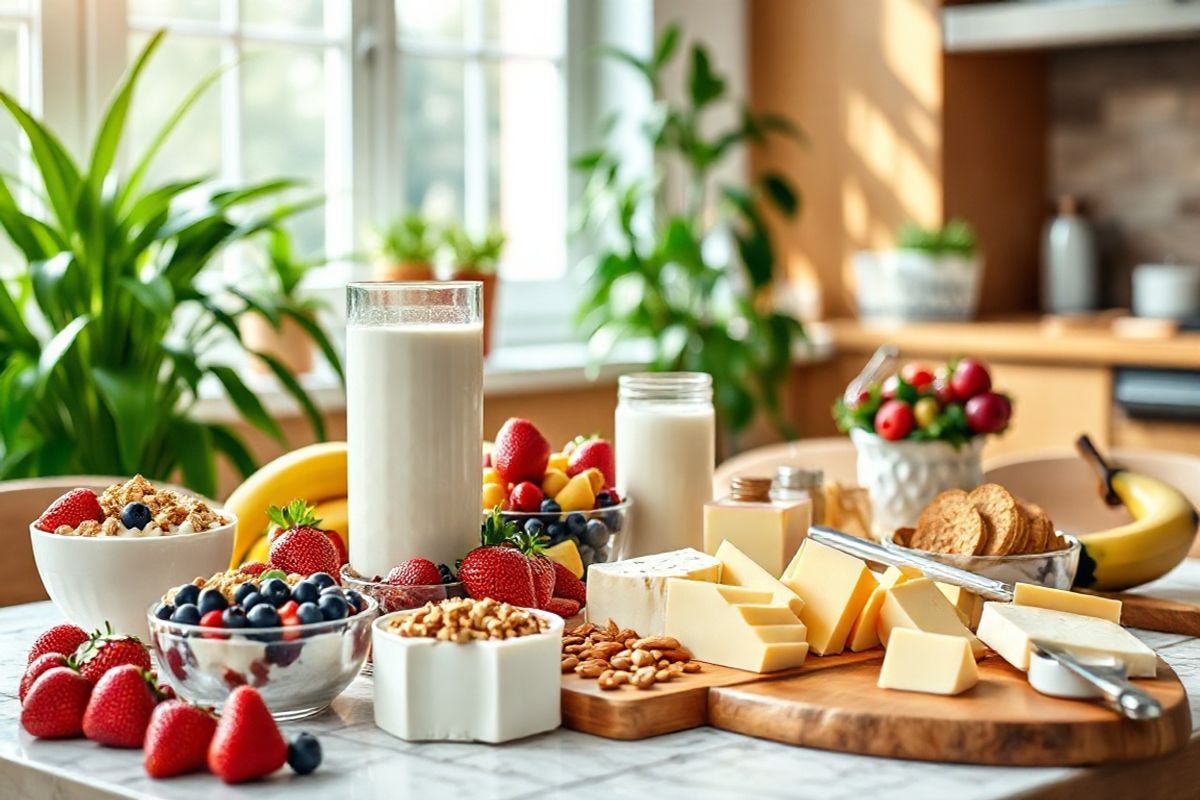Table of Contents
What is Lactose Intolerance and How Does it Affect Digestion?

Lactose intolerance occurs when the small intestine does not produce enough lactase, the enzyme needed to break down lactose into glucose and galactose for absorption (1). When lactose is not adequately digested, it travels to the large intestine, where bacteria ferment it, leading to the production of gases and acids. This fermentation process is responsible for the uncomfortable symptoms associated with lactose intolerance, including bloating, diarrhea, and abdominal pain (2).
Most mammals, including humans, produce lactase during infancy to digest breast milk. However, after weaning, the production of lactase typically decreases. While many individuals of Western European descent maintain lactase production into adulthood, populations in Asia, Africa, and the Middle East often experience a reduction in lactase levels, resulting in higher rates of lactose intolerance (1).
Common Symptoms of Lactose Intolerance: Recognizing the Signs

The symptoms of lactose intolerance can vary from person to person and typically manifest within a few hours after consuming lactose-containing foods. Commonly reported symptoms include:
- Abdominal pain: Cramping or sharp pain can occur due to the fermentation of undigested lactose.
- Bloating: Excess gas production leads to a feeling of fullness and distension in the abdomen.
- Flatulence: Increased gas production results in more frequent gas passing.
- Diarrhea: Unabsorbed lactose draws water into the intestines, leading to watery stools (3).
Individuals who suspect they may be lactose intolerant should consult with a healthcare professional to discuss their symptoms and potential dietary modifications.
Unpacking the Causes of Lactose Intolerance: Genetic and Environmental Factors
Lactose intolerance is primarily influenced by genetic factors. A specific genetic makeup leads to varying levels of lactase production, which can significantly affect an individual’s tolerance to lactose (4). While primary lactose intolerance, which typically develops after weaning, is genetically determined, secondary lactose intolerance can occur due to temporary conditions such as gastroenteritis or chronic intestinal diseases that damage the gut lining, resulting in reduced lactase production (5).
Genetic Factors
Research indicates that lactose tolerance is closely tied to the genetic mutation prevalent in populations of Northern European descent. This mutation allows for continued lactase production throughout adulthood, which is less common in other global populations (6).
Environmental Factors
Environmental influences such as gastrointestinal infections, chronic illnesses, or dietary habits can also lead to secondary lactose intolerance. For instance, infections that damage the intestinal lining can temporarily reduce lactase levels, affecting an individual’s ability to digest lactose (7).
Effective Diagnosis of Lactose Intolerance: Tests and Methods Explained
Diagnosing lactose intolerance typically involves a combination of medical history, symptom assessment, and specific tests. Common diagnostic methods include:
- Hydrogen breath test: This test measures the amount of hydrogen in the breath after consuming a lactose-rich beverage. If lactose is not properly digested, bacteria in the gut produce hydrogen, which is exhaled (8).
- Lactose tolerance test: Blood tests are conducted before and after consuming a lactose-containing drink. A lack of increase in blood glucose levels indicates lactose malabsorption (9).
- Elimination diet: Patients may be advised to remove lactose from their diet for a period, followed by a gradual reintroduction to observe symptom recurrence (10).
These tests help healthcare providers confirm lactose intolerance and rule out other gastrointestinal disorders that may present with similar symptoms.
Managing Digestive Issues: Dietary Changes and Treatment Options for Lactose Intolerance
Managing lactose intolerance primarily revolves around dietary modifications to mitigate symptoms while ensuring nutritional needs are met. Here are some effective strategies:
Dietary Changes
-
Limit lactose intake: Individuals should identify and limit foods high in lactose, such as milk, soft cheeses, and ice cream. It’s important to note that hard cheeses and yogurt often contain lower lactose levels and may be better tolerated (11).
-
Lactose-free alternatives: Many lactose-free products, including milk and yogurt, are available on the market. These products provide the same taste and texture without the digestive discomfort associated with lactose (12).
-
Incorporate lactase supplements: Over-the-counter lactase enzyme supplements can help individuals digest lactose when consuming dairy products. These supplements can be taken prior to meals to reduce symptoms (13).
-
Nutrient balance: It’s crucial to maintain a balanced diet rich in calcium and vitamin D, which are often obtained from dairy products. Alternatives to dairy include fortified plant-based milks, leafy greens, and fortified cereals (14).
Treatment Options
In cases where lactose intolerance is caused by an underlying condition, treating that condition may restore the body’s ability to digest lactose. For example, addressing intestinal infections or inflammatory bowel disease (IBD) may improve lactase production (15).
Frequently Asked Questions (FAQ)
What is lactose intolerance? Lactose intolerance is a condition characterized by digestive symptoms that occur after consuming lactose, a sugar found in milk and dairy products, due to insufficient levels of the enzyme lactase.
What are the symptoms of lactose intolerance? Common symptoms include abdominal pain, bloating, gas, and diarrhea occurring after the consumption of lactose-containing foods.
How is lactose intolerance diagnosed? Diagnosis typically involves a hydrogen breath test, lactose tolerance test, and potentially an elimination diet to observe symptom changes.
Can I still consume dairy if I am lactose intolerant? Many individuals with lactose intolerance can tolerate small amounts of lactose or consume lactose-free dairy products without experiencing symptoms.
What dietary changes can help manage lactose intolerance? Limiting high-lactose foods, incorporating lactose-free alternatives, and using lactase enzyme supplements can help manage symptoms effectively.
References
-
National Institute of Diabetes and Digestive and Kidney Diseases. (2020). Definition & Facts for Lactose Intolerance. Retrieved from https://www.niddk.nih.gov/health-information/digestive-diseases/lactose-intolerance/definition-facts
-
Better Health Victoria. (n.d.). Lactose intolerance. Retrieved from https://www.betterhealth.vic.gov.au/health/conditionsandtreatments/lactose-intolerance
-
Mayo Clinic. (2020). Diagnosis & treatment. Retrieved from https://www.mayoclinic.org/diseases-conditions/lactose-intolerance/diagnosis-treatment/drc-20374238
-
Hammer, H. F., et al. (2020). Lactose intolerance: Clinical manifestations, diagnosis, and management
-
Di Costanzo, M., et al. (2018). Lactose intolerance: Common misunderstandings. Annals of Nutrition & Metabolism. doi:10.1159/000493669.
-
Cleveland Clinic. (n.d.). Gastrointestinal Diseases: Symptoms, Treatment & Causes. Retrieved from https://my.clevelandclinic.org/health/articles/7040-gastrointestinal-diseases
-
Medical News Today. (n.d.). Common stomach & gastrointestinal (GI) issues. Retrieved from https://www.tylenol.com/adult-relief/stomach-conditions/gastrointestinal-issues
-
Mount Elizabeth. (n.d.). 7 Common Digestive Problems You May Have. Retrieved from https://www.mountelizabeth.com.sg/health-plus/article/common-digestive-problems
-
Digestive Diseases: MedlinePlus Medical Encyclopedia. (n.d.). Retrieved from https://medlineplus.gov/ency/article/007447.htm
-
UF Health. (n.d.). Digestive diseases. Retrieved from https://ufhealth.org/conditions-and-treatments/digestive-diseases










